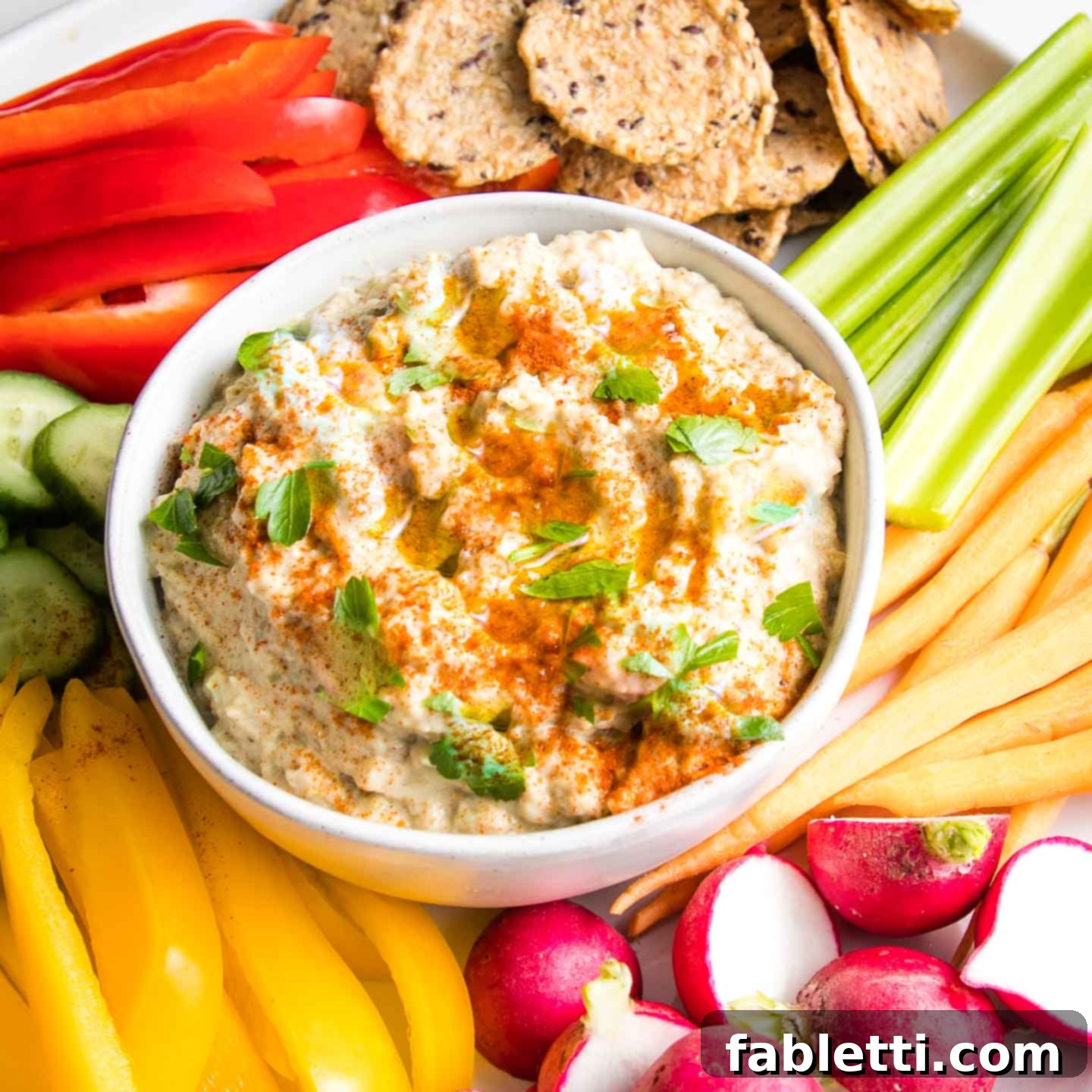Delight your senses with the ultimate Baba Ganoush, a luscious roasted eggplant dip that transcends the ordinary. Forget about the endless debate between Baba Ganoush and Hummus; once you experience this recipe, you’ll undoubtedly join the ranks of “Team Baba Ganoush.” Our unique approach elevates this classic Mediterranean appetizer by infusing it with the unparalleled depth of flavor from expertly roasted garlic and sweetly caramelized vegetables. This isn’t just any eggplant dip; it’s a creamy, dairy-free, and healthy vegan snack that perfectly complements any Mediterranean feast, delivering a taste experience that is simply the best.
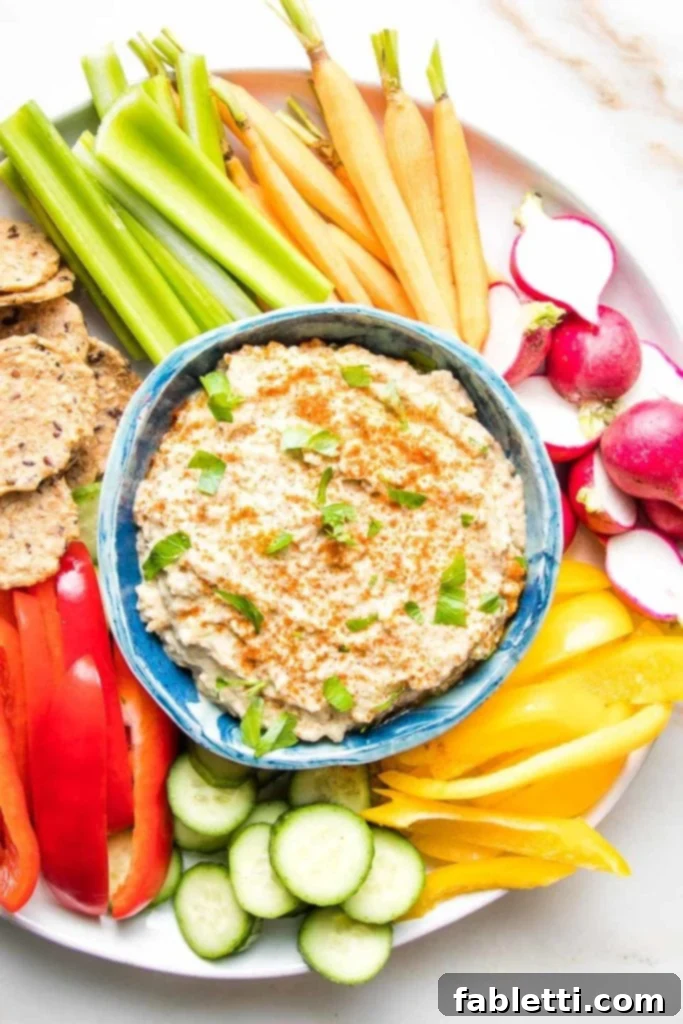
The Enchanting World of Baba Ganoush: A Culinary Journey
Baba Ganoush, a beloved staple in Middle Eastern and Mediterranean cuisine, is far more than just a dip. Its origins are shrouded in delightful lore, often said to have been invented by a sultan’s concubine – hence the affectionate name “Baba Ganoush,” meaning “pampered papa” or “flirtatious father,” referring to its ability to spoil anyone who tastes it. This traditional dish, primarily made from roasted eggplant, tahini, lemon juice, and garlic, offers a smoky, creamy texture that is utterly irresistible. Unlike its counterpart, hummus, which is chickpea-based, Baba Ganoush boasts a distinct earthy depth that comes alive with the magical transformation of eggplant through roasting.
For those of us who adore the rich flavors of the Mediterranean, Baba Ganoush is a culinary cornerstone. It’s not just a dip; it’s an experience. Perfect for a casual snack with pita bread, an elegant starter with a vibrant assortment of crudités, or as a shining star on a grand mezze platter. Imagine it alongside crispy baked falafel, tender cauliflower shawarma or savory tofu shawarma, cool dairy-free tzatziki, briny olives, and sweet roasted carrots. This recipe is designed to bring you the absolute best version of this classic, highlighting the smoky sweetness of roasted eggplant and the aromatic punch of garlic, all harmonized with creamy tahini and zesty lemon.
Key Ingredients for the Perfect Baba Ganoush
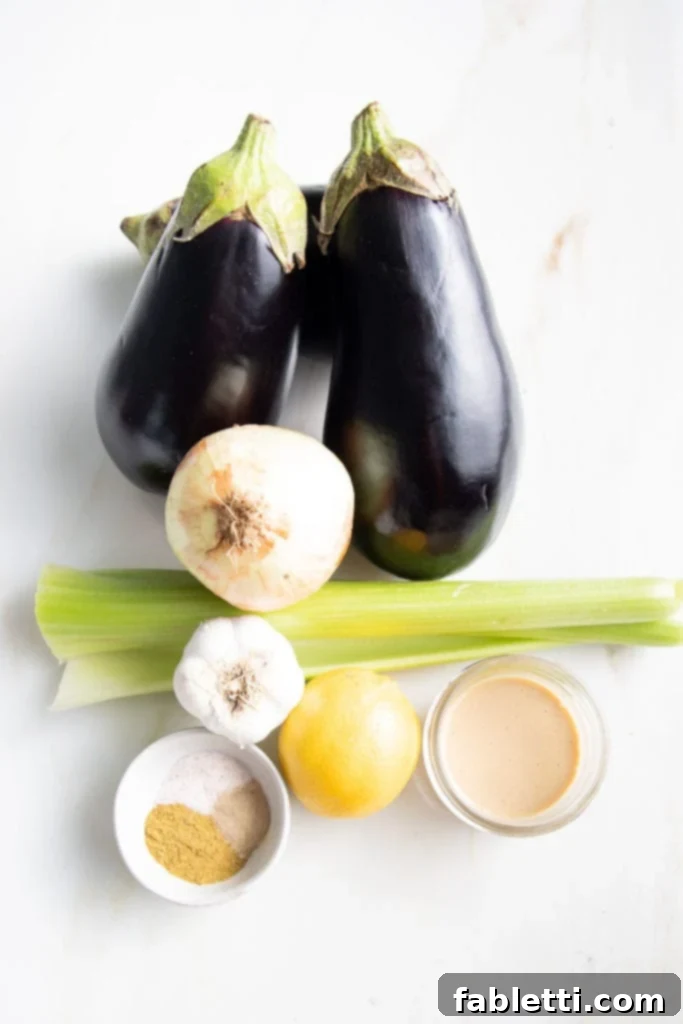
Crafting the best Baba Ganoush starts with understanding the unique contribution of each ingredient. This recipe is meticulously balanced to deliver a symphony of flavors and textures, ensuring every scoop is a delight.
- Roasted Eggplant: The Heart of the Dip
We typically use about 2 pounds of eggplant, which could be one large, two medium, or three smaller eggplants. I highly recommend opting for smaller eggplants when possible. Not only do they tend to cook more quickly and evenly, but they also often contain less bitterness, resulting in a sweeter, more tender final product. Roasting the eggplant is non-negotiable for authentic Baba Ganoush, as it imparts that essential smoky flavor and silky texture that sets this dip apart. - Roasted Garlic: A Mellow & Flavorful Boost
This is where our recipe truly shines! Roasting garlic transforms its pungent, sharp “bite” into a wonderfully smooth, mellow, and slightly sweet flavor. This means you can use more garlic without it overpowering the dish or causing digestive discomfort like heartburn or acid reflux for some individuals. Beyond its incredible taste, garlic is a powerful ingredient packed with health benefits, known for its anti-inflammatory and antioxidant properties, and rich in essential vitamins. It’s a flavor builder and a health booster all in one! - Tahini: Creaminess and Distinctive Sesame Flavor
Tahini, a paste made from ground sesame seeds, is crucial for achieving the creamy, rich texture of Baba Ganoush. It also introduces a distinctive nutty, earthy flavor that is fundamental to traditional Middle Eastern dips. Unlike mayonnaise, which offers unhealthy fats without nutritional benefits, tahini contributes healthy fats, protein, and essential minerals, making this dip not just delicious but genuinely nourishing. The deep sesame notes are absolutely “clutch” in this recipe, adding an authentic layer of complexity. - Fresh Lemon Juice: The Balancing Act
Freshly squeezed lemon juice is vital for balancing all the rich flavors in Baba Ganoush. Its bright tanginess cuts through the richness of the tahini and the earthiness of the eggplant, preventing the dip from becoming heavy. It provides a refreshing acidity that I prefer over adding more oil or excessive salt, ensuring a vibrant and fresh taste profile. - Caramelized Onions and Celery: Sweetness and Depth
This is our secret weapon for building authentic, complex flavors. Eggplant, on its own, can be somewhat bland. However, by caramelizing onions and celery until they release their natural sugars and develop a golden hue, we introduce an incredible depth of sweetness and savory notes that elevate the dip from good to extraordinary. This slow cooking process extracts and concentrates their flavors, creating a rich foundation for the Baba Ganoush. - Spices: Cumin, Salt, and White Pepper
These spices are carefully chosen to enhance the existing flavors without overwhelming them. Ground cumin provides a warm, earthy essence that is quintessential to Middle Eastern cuisine. Coarse sea salt brings out the natural flavors of the vegetables, and a touch of white pepper adds a subtle, refined heat that rounds out the profile. Adjust these to your preference to achieve your perfect balance.
Mastering the Roast: Eggplant & Garlic Perfection
The magic of this Baba Ganoush recipe truly begins in the oven. Roasting is the foundational step that unlocks the incredible depth of flavor from both the eggplant and the garlic. While your oven is already on, it’s incredibly efficient and beneficial to roast both ingredients simultaneously, maximizing flavor with minimal effort.
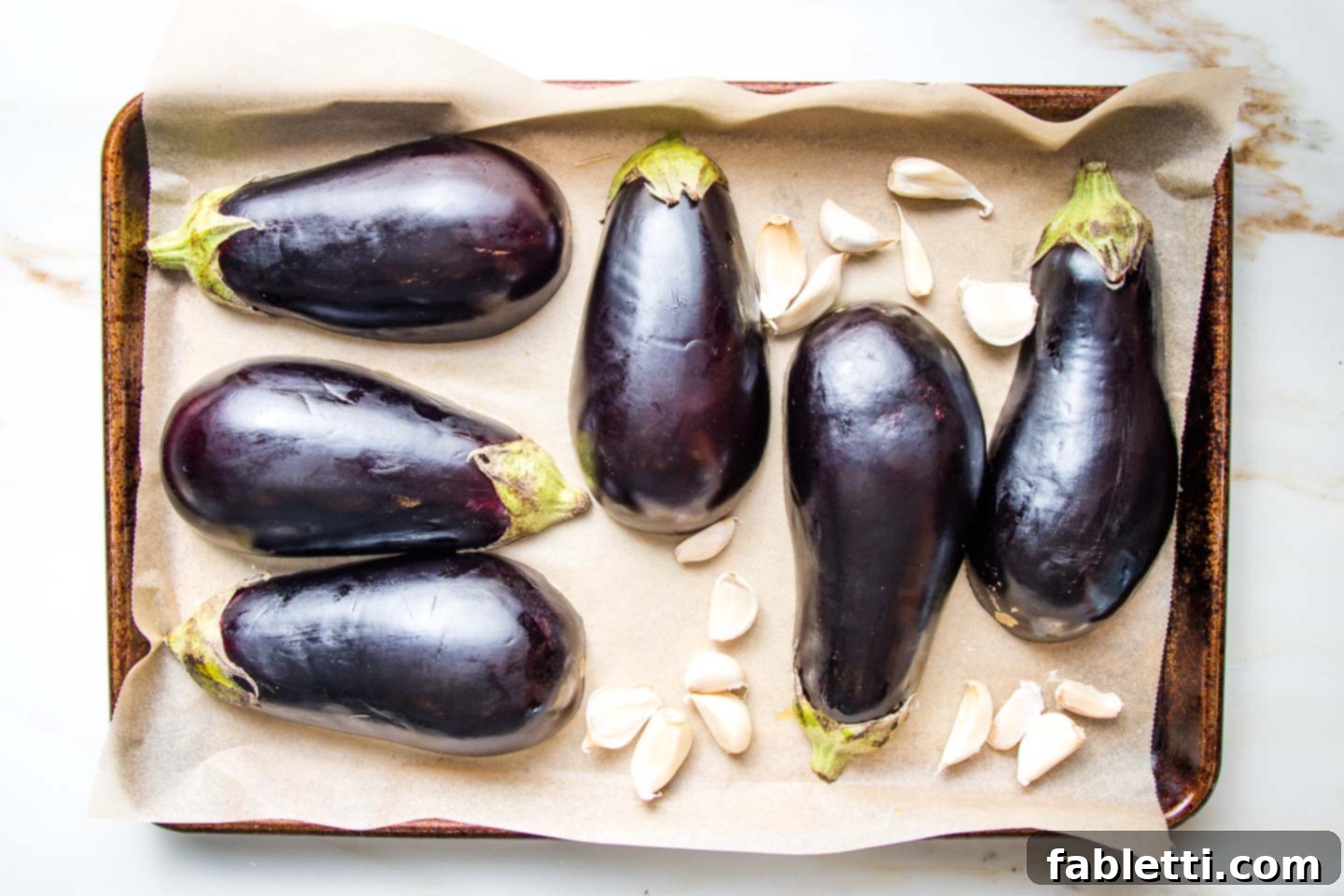
Step 1: Preparing for the Roast
Begin by preheating your oven to a robust 400°F (200°C). Line a rimmed baking sheet with unbleached parchment paper, which prevents sticking and makes cleanup a breeze. Take your eggplant(s) and slice them in half lengthwise. Drizzle the cut side generously with about 1 tablespoon of olive oil. Place the eggplant halves cut-side down on the prepared tray. Arrange the garlic cloves, keeping their skins intact, scattered around the eggplant on the same pan. Leaving the skins on the garlic is crucial; it acts as a protective layer, preventing the delicate flesh from burning and allowing it to slow-roast into a buttery, sweet perfection.

Step 2: The Roasting Process
Roast the eggplant and garlic in your preheated oven for 30-40 minutes. The exact timing can vary depending on the size and moisture content of your eggplants. You’ll know the eggplant is perfectly done when its skin begins to shrivel and cave in, and the flesh feels incredibly tender when pierced with a fork. The garlic cloves will be soft and fragrant, easily squeezable from their skins. Roasting transforms the eggplant’s somewhat spongy texture into a rich, creamy pulp with a desirable smoky depth, which is essential for our Baba Ganoush. This process not only enhances flavor but also makes the garlic easier to digest for many individuals who are sensitive to raw garlic’s acidity.
Creating Depth: Caramelizing Onions and Celery
While your eggplant and garlic are roasting to perfection in the oven, you can begin the next crucial step: caramelizing the onions and celery. This seemingly simple process adds an incredible layer of sweet, savory complexity that truly elevates the flavor profile of your Baba Ganoush.
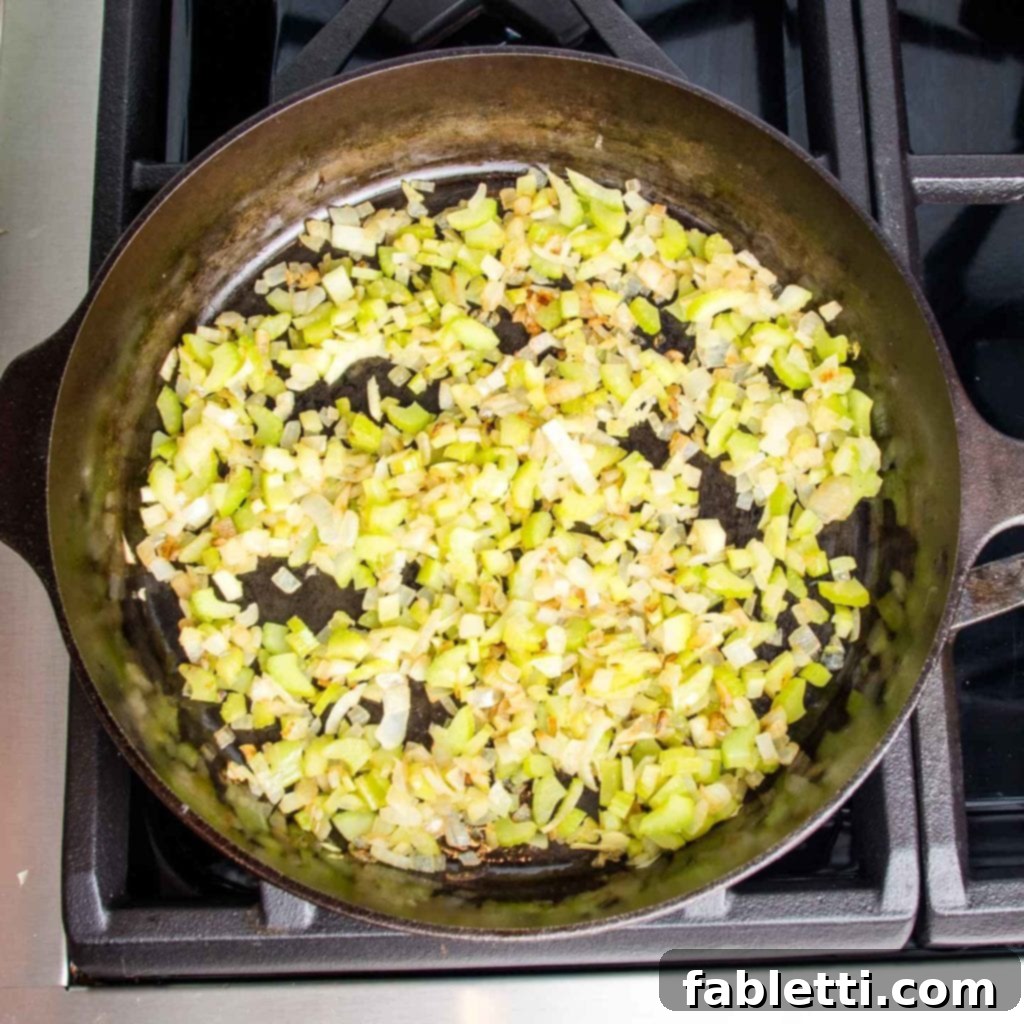
First, finely dice your medium onion and two ribs of celery. Precision here helps achieve a smoother texture in the final dip. Heat a cast iron skillet or another heavy-bottomed pan over medium-low heat. Cast iron is excellent for even heat distribution, which is key for proper caramelization. Swirl in the remaining 1 tablespoon of olive oil, then add the diced onions and celery to the pan. Cook them gently, stirring occasionally, for about 8-10 minutes. The trick here is to maintain a lower heat; this prevents the vegetables from burning and instead allows their natural sugars to slowly release and caramelize, developing a profound sweetness and rich, savory notes. You’ll see them soften considerably and turn a beautiful golden-brown color.
Once caramelized, transfer these fragrant, softened vegetables directly into the bowl of your food processor. This aromatic base will infuse your Baba Ganoush with an extra layer of gourmet flavor, distinguishing it from simpler versions of the dip.
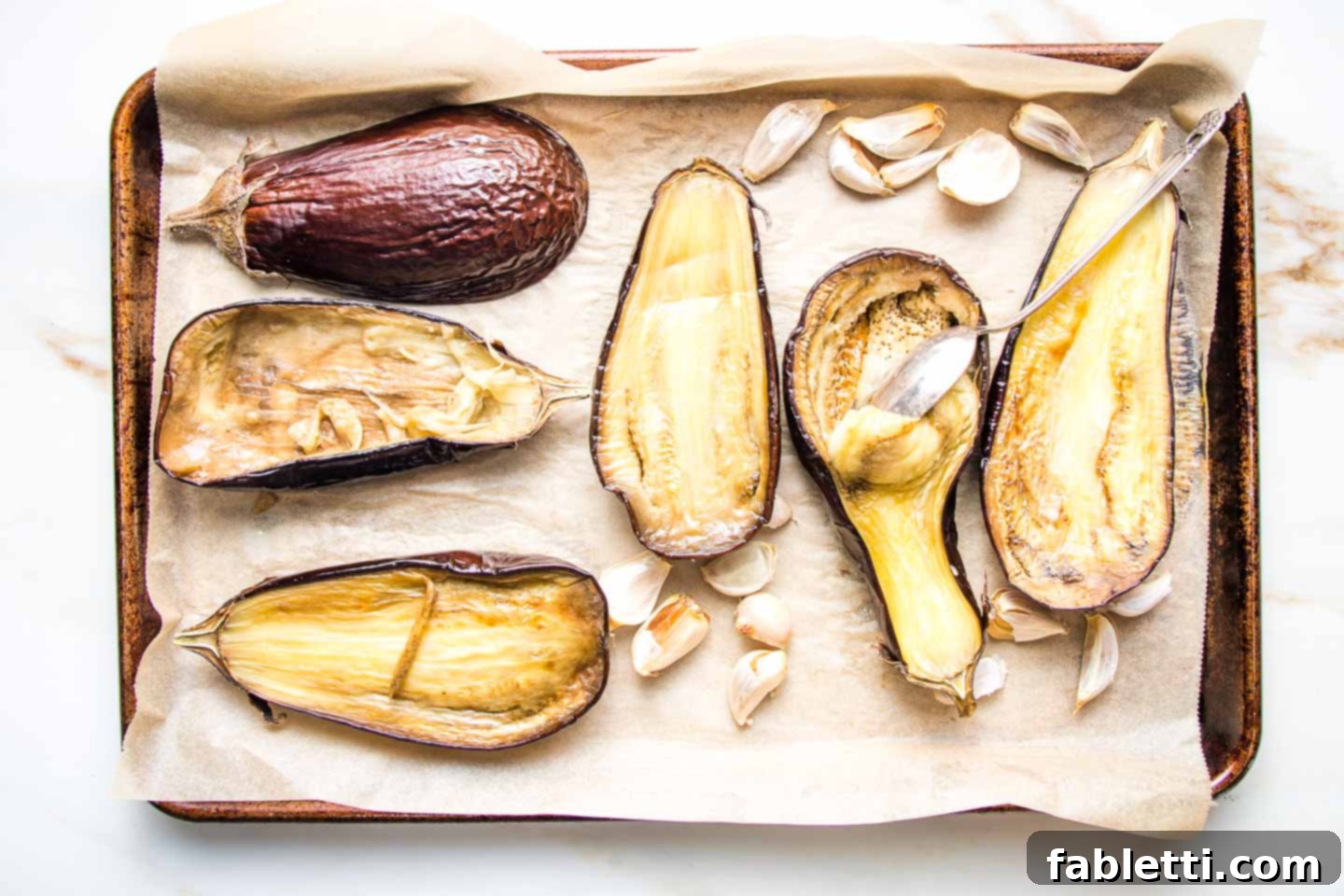
As soon as the roasted eggplant is tender and its sides have collapsed, remove it from the oven. Allow the garlic to cool slightly so it’s comfortable to handle. With a large spoon, carefully scoop out the creamy, smoky flesh of the eggplant directly into the food processor bowl, joining the caramelized onions and celery. Then, gently squeeze the soft, roasted garlic pulp from its skins into the same bowl. Discard the eggplant skins and garlic peels.
Crafting the Creamy Delight: How to Make Baba Ganoush
Now that your star ingredients are prepped, it’s time to bring them together into the smooth, flavorful dip we’ve been anticipating. A food processor is ideal for achieving the perfect consistency, but a blender works well, and for a rustic, chunkier dip, a potato masher is a perfectly acceptable tool.

Step 1: Initial Processing
Place the roasted eggplant pulp, roasted garlic, and caramelized onions and celery into the bowl of your food processor. Pulse the mixture a few times until everything starts to come together and is coarsely chopped. You’re aiming for a somewhat chunky base at this stage, allowing the flavors to begin to meld.
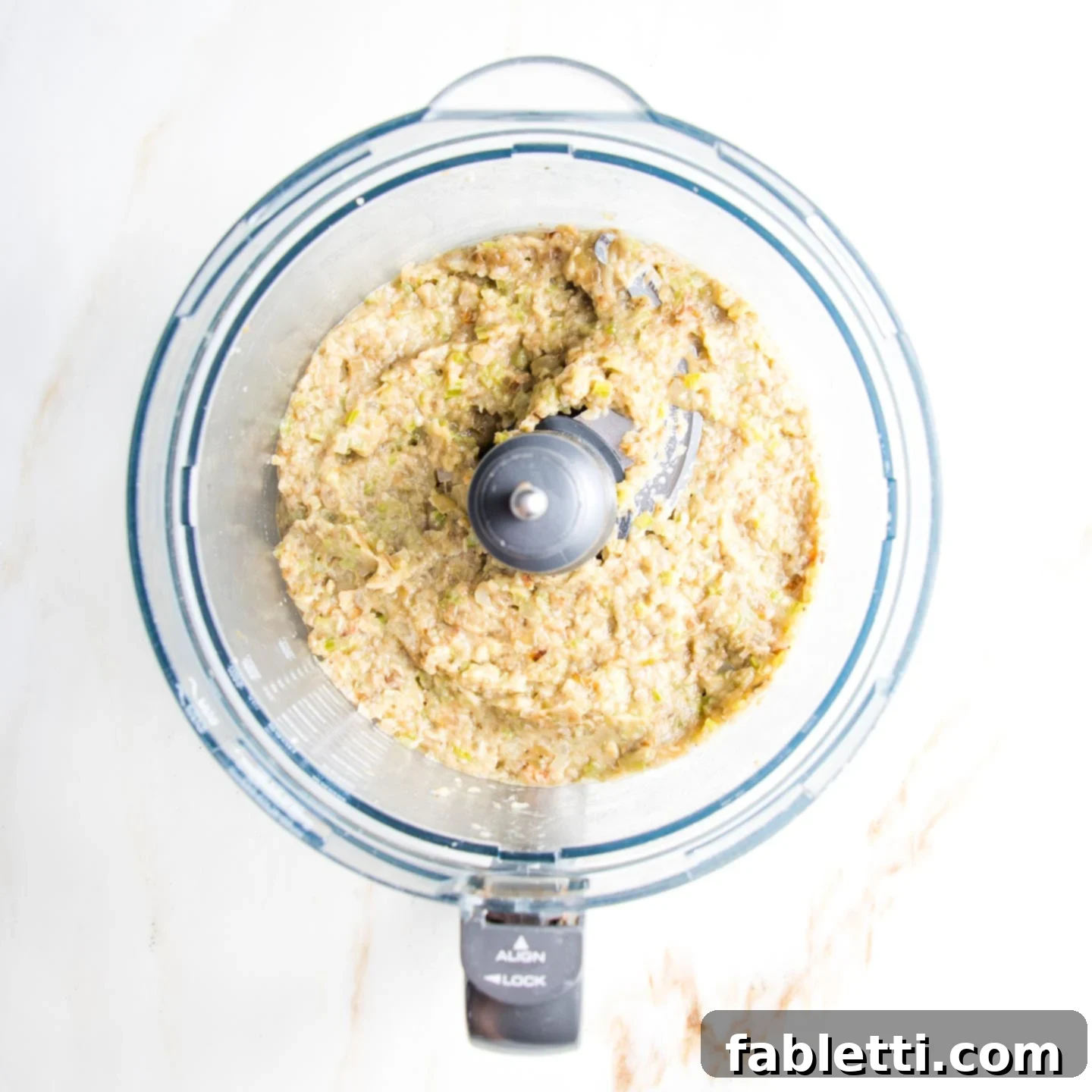
Step 2: Combining the Essentials
Once the mixture is coarsely chopped, add the tahini, fresh lemon juice, ground cumin, coarse sea salt, and white pepper to the food processor bowl. These are the key ingredients that will transform the roasted vegetables into a rich, creamy, and tangy Baba Ganoush.
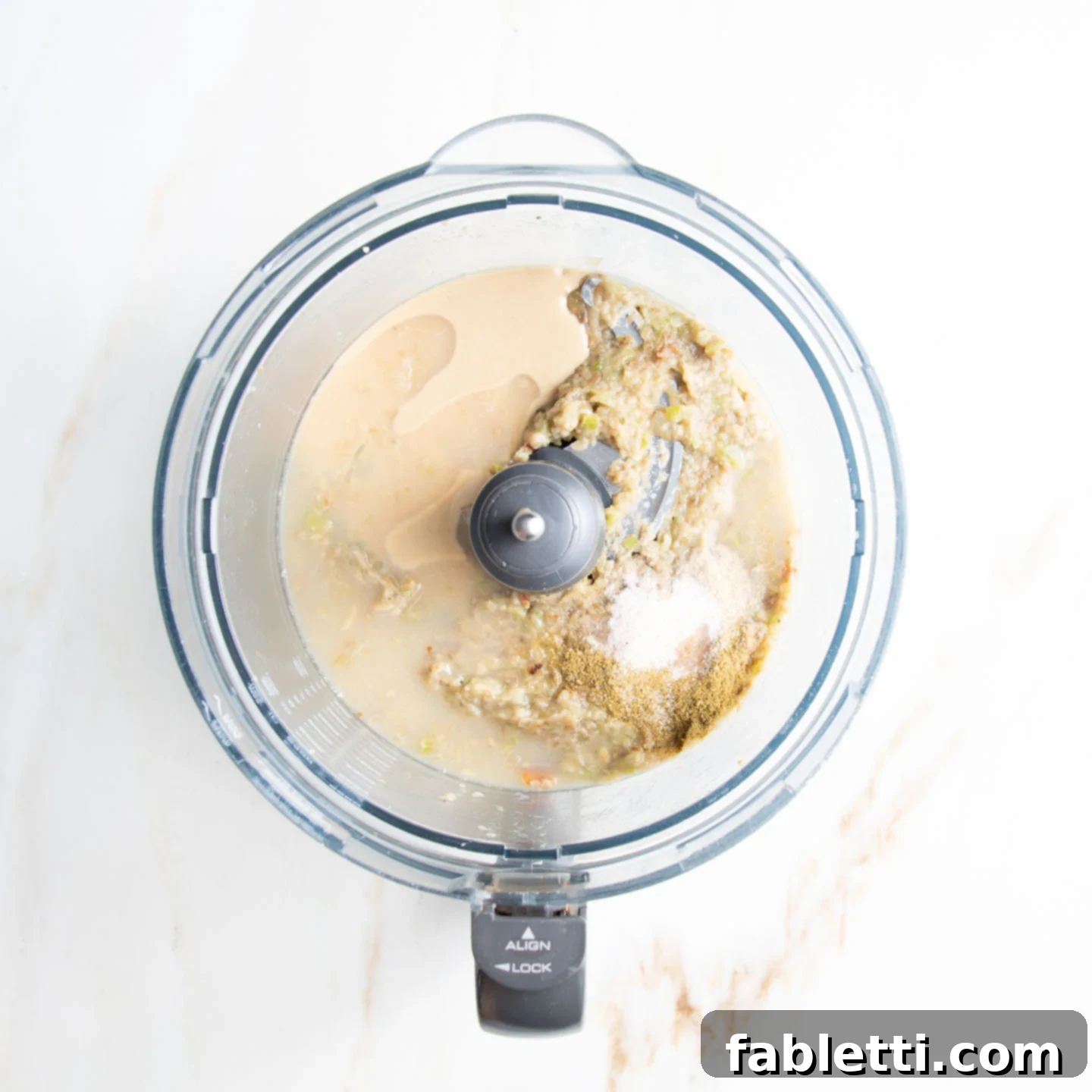
Step 3: Achieving Creamy Perfection
Process the mixture continuously, pausing every so often to scrape down the sides of the bowl with a spatula. This ensures all ingredients are thoroughly incorporated and that you achieve a uniform consistency. Continue processing until the dip is beautifully smooth and creamy. If you prefer a slightly chunkier texture, process for less time; for a super silky dip, process for longer.

Step 4: Seasoning and Adjustments
Once you’ve reached your desired consistency, taste the Baba Ganoush and adjust the seasonings as needed. You might want to add a bit more salt or a pinch more white pepper. If the dip feels too thick, a small splash of additional lemon juice can thin it out and brighten the flavor. Conversely, if it’s a bit too thin, adding another tablespoon of tahini can help thicken it and add more richness. Aim for a balance that excites your palate.
Pro Tips for the Best Baba Ganoush Experience

- The Art of Garnishing: Presentation matters! Before serving, create a small well in the center of your Baba Ganoush. Drizzle generously with a high-quality extra virgin olive oil for a silken finish and enhanced flavor. Sprinkle with a vibrant dash of paprika for color, or a pinch of za’atar for an aromatic, herbal note. Finish with finely minced fresh flat-leaf parsley for a burst of freshness and visual appeal. Lemon wedges on the side are also a great touch.
- Hand-Mashing for Rustic Charm: If you’re opting for a potato masher instead of a food processor, make sure to dice your onions and celery into super small pieces before sautéing. This will help achieve a smoother, more palatable texture in your chunky dip. The rustic texture of hand-mashed Baba Ganoush is a delightful alternative!
- Elevate with a Savory Topping: For an exceptionally satisfying meal, top your Baba Ganoush with a few scoops of flavorful vegan ground beef. This transforms it into a hearty, protein-rich dish that’s perfect for a more substantial meal.
- Flavor Fine-Tuning: Always taste and adjust! If you crave more zing, add an extra tablespoon of fresh lemon juice. For a delightful kick of heat, sprinkle in a pinch of cayenne pepper. Don’t be shy; customize it to your personal preference.
- Storage and Make-Ahead: Baba Ganoush is excellent for meal prepping. Store it in an airtight container in the refrigerator, where it will stay fresh and delicious for up to 5 days. The flavors often deepen and meld beautifully overnight, making it an ideal make-ahead appetizer.
- Serving Temperature Versatility: While often served chilled, Baba Ganoush is equally delicious served warm or at room temperature. Experiment to find your favorite way to enjoy it!
After you’ve had a chance to whip up this incredible Baba Ganoush recipe, I’m genuinely curious: are you still firmly on “Team Hummus”? I have a strong suspicion that once you taste this perfectly balanced, smoky, and creamy dip, you might just find yourself switching sides. Of course, if you’re comparing it to my cauliflower hummus (which also features roasted garlic and a similar flavor profile), it might be a close call—even I struggle to pick a favorite sometimes! Let me know your verdict in the comments below. Your feedback and culinary adventures inspire us all!
Did you know commenting and rating recipes is one of the best ways to support your favorite food bloggers? If you made this recipe, please consider a five-star rating below and leave a comment. Also, please share your photos on Instagram by tagging me @dkhealthcoach and using the hashtag #debraklein. I love seeing your creations!
📖 Recipe
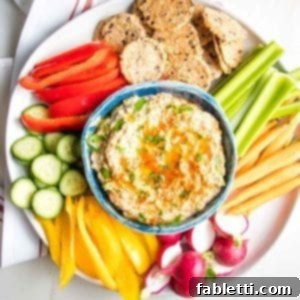
Baba Ganoush with Roasted Garlic and Tahini
Author: Debra Klein
The Best Baba Ganoush is made with Roasted Eggplant and Garlic plus sauteed veggies. Tahini plus lemon juice provide a dairy-free creamy texture for a delicious dip.
5 from 45 votes
Rate this Recipe
Pin Recipe
Recipe Details
Categorization
Serving & Nutrition
Equipment
- Food Processor
- Cast iron skillet
- Extra Large Bamboo Cutting Board
- Global 8″ Chef’s Knife
- Parchment Baking Paper
- Half Sheet Baking Pans
Ingredients
- 2 lbs. eggplant*
- 2 Tablespoons olive oil divided
- 6 cloves garlic skins still on
- 1 medium onion* diced
- 2 ribs celery* diced
- ¼ cup tahini
- ¼ cup fresh lemon juice*
- 1 teaspoon ground cumin
- ½ teaspoon coarse sea salt
- ¼ teaspoon white pepper*
Instructions
- Preheat oven to 400°F (200°C) and line a rimmed baking tray with unbleached parchment paper.
- Cut eggplant in half lengthwise and drizzle the cut side with 1 Tablespoon olive oil. Place cut side down on the prepared tray. Scatter garlic cloves, skins still on, onto the tray. Roast for 30-40 minutes, depending on size, until the sides are caving in and the flesh is easy to prick with a fork.
- Meanwhile, dice onion and celery. Heat a cast iron or other skillet over medium-low heat. Swirl in the remaining Tablespoon olive oil, then add the diced onions and celery. Cook until soft and beginning to caramelize, about 8-10 minutes. Transfer cooked veggies to the bowl of a food processor.
- When eggplant is done, it will be tender throughout and the skin will collapse. Scoop out the flesh and add to the food processor with the veggies. Squeeze the garlic out of its skins and into the processor bowl as well. Process until thoroughly mixed. Then, add tahini, lemon juice, cumin, salt, and white pepper. Process until smooth and creamy.
- Taste for seasoning, adding additional salt and pepper as desired. If the eggplant dip is too thin, add additional tahini. If it’s too thick, add a bit more lemon juice until desired consistency is achieved.
- Serve warm, at room temperature, or allow to chill before serving. Make a well in the center, drizzle with some good olive oil, and sprinkle with paprika or za’atar. Baba Ganoush will stay good in the fridge for 5 days in an airtight container.
Notes
EGGPLANT: 2 lbs. typically translates to 1 large, 2 medium, or 3 small eggplants. Smaller eggplants are often preferred as they tend to be less bitter and cook more evenly. Cooking times may vary (30-40 minutes) based on eggplant size.
ONION: One medium onion will yield approximately ½ cup when diced.
CELERY: Two ribs of celery will yield about ½ cup diced. If your celery stalks are particularly small, you might need to use 3.
LEMON JUICE: For a tangier flavor profile, consider adding an additional tablespoon of fresh lemon juice after tasting.
WHITE PEPPER: I personally enjoy a bit more subtle heat in my eggplant dip, so I often use ½ teaspoon of white pepper. Adjust to your preference.
GARNISH SUGGESTIONS: Enhance your Baba Ganoush with fresh flat-leaf parsley (minced), a sprinkle of paprika, chili powder, or za’atar, a drizzle of high-quality extra virgin olive oil, and lemon wedges for serving.
SERVING SUGGESTIONS: This versatile dip pairs perfectly with toasted pita wedges, an assortment of crackers, fresh crudités (such as bell peppers, carrots, cucumbers, radishes), or as a component of a falafel plate/pita.
Nutrition
Serving: 1g
Calories: 158kcal
Carbohydrates: 14g
Protein: 5g
Fat: 10g
Saturated Fat: 2g
Polyunsaturated Fat: 7g
Cholesterol: 9mg
Sodium: 149mg
Fiber: 4g
Sugar: 5g
Note
The nutrition calculations were done using online tools. To obtain the most accurate representation of the nutritional information in any given recipe, you should calculate the nutritional information with the actual ingredients you used. You are ultimately responsible for ensuring that any nutritional information is accurate, complete and useful.
